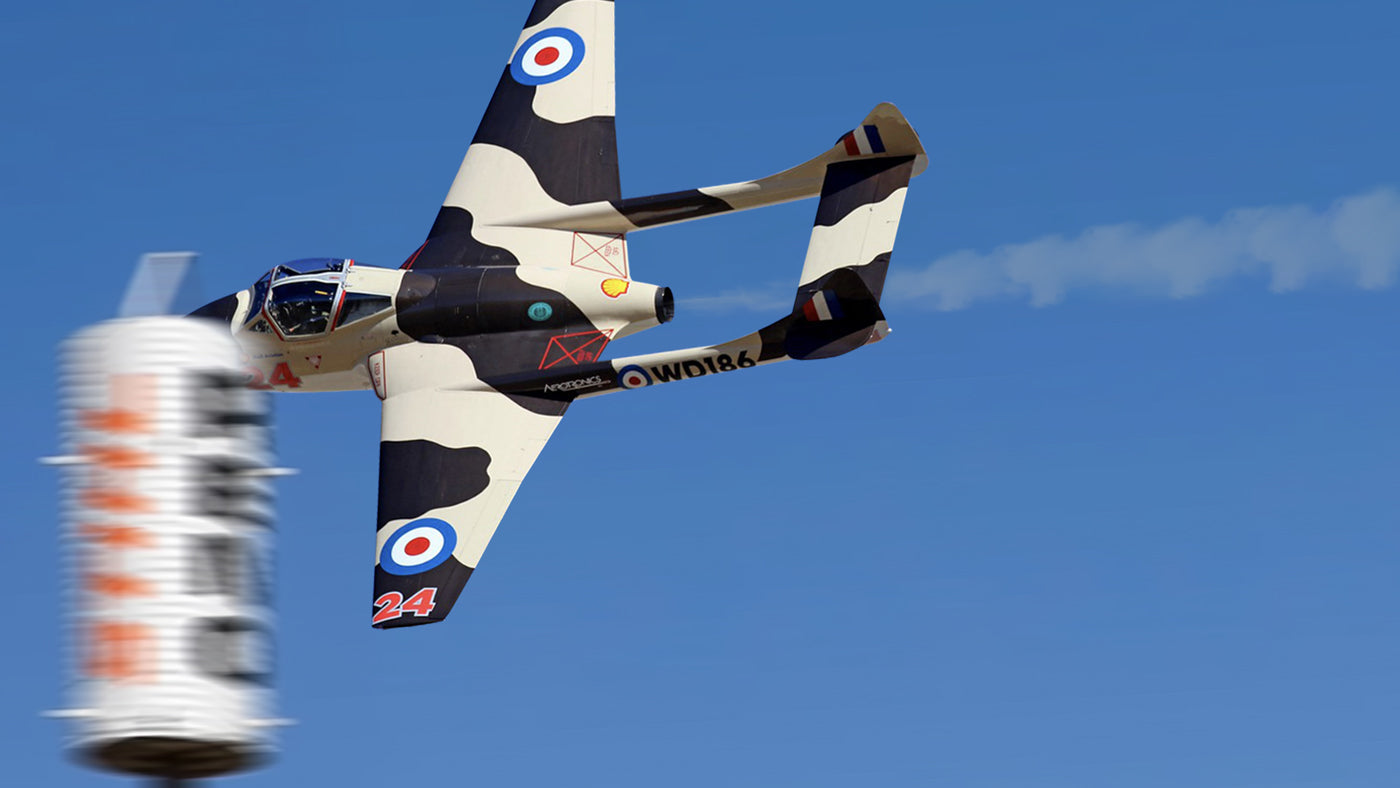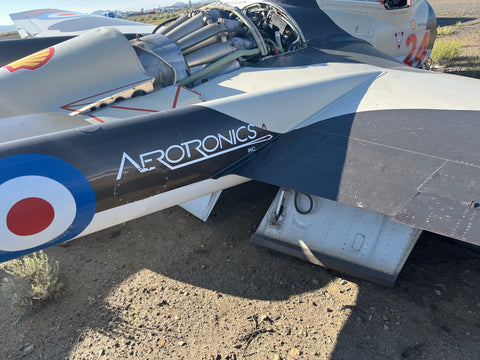
- by Dianna Lopez
De Havilland Vampire: From Jet Fighter to Gold Racer
- by Dianna Lopez
A question? Visit our contact page
This site uses cookies for better user experience and analytics.

As the National Championship Air Races commence their final year in Reno, Nevada, MotoArt is honored to share in preserving the legacy of one amazing de Havilland DH.115 Vampire T.55. Read more about the Vampire, particularly N4861K which served with the Irish Air Corps before becoming a Gold race winner, and check out the new De Havilland Vampire PlaneTags.
The De Havilland Vampire is a jet-powered aircraft that played a significant role in the early development of jet aviation. It was designed and built by the British aircraft manufacturer De Havilland during the late 1940s and early 1950s. The Vampire was one of the first successful jet fighters and served in various roles with multiple air forces around the world.

DeHavilland Vampire flickr photo by San Diego Air & Space Museum Archives shared with no copyright restriction (Flickr Commons)
The Vampire was powered by a powerful de Havilland Goblin engine, later a De Havilland Ghost engine, which was a distinguishing feature at the time of its development. In its era, the Vampire was known for its impressive speed, reaching speeds of approximately 548 mph (881 km/h). It was agile and had good handling characteristics, making it a favorite among pilots.
The Vampire boasted a distinctive and eye-catching appearance that set it apart from other aircraft. The bubble-like cockpit canopy along with the sleek, streamlined fuselage exuded speed and modernity. Its distinctive gull-shaped wings allowed for the placement of the retractable landing gear while maintaining adequate ground clearance. Another distinctive feature was its twin tail-boom design, one chosen to allow its design to include a single turbojet engine. It was the first operational jet fighter with one engine.
In fact, the Vampire had many other firsts. On December 3, 1945, a Vampire flown by Lt Cdr Eric "Winkle" Brown performed the first jet landing on an aircraft carrier. It was also the first jet aircraft to cross the Atlantic Ocean, which occurred on July 14, 1948. The Vampire was also the first RAF fighter with a top speed in excess of 500 mph (800 km/h).
Its versatility made the Vampire capable of serving in various roles, including air-to-air combat, ground-attack missions, and as a trainer aircraft. It was used by several countries, including the United Kingdom, Sweden, Switzerland, Australia, and others. It played a crucial role in dozens of post-World War II air forces, including the Irish Air Corps.
De Havilland Aviation was a British aircraft manufacturer with a rich history dating back to the early 20th century. The company played a significant role in the development of aviation technology and produced several iconic aircraft over the years.

de Havilland Vampire T55 & FB6 flickr photo by Dave_S. shared under a Creative Commons (BY) license
De Havilland Aircraft Company Limited was founded by Geoffrey de Havilland in 1920. De Havilland's early designs included a series of innovative aircraft, such as the DH.4, which was used during World War I, and the DH.9 bomber. Here are some of the notable aircraft introduced by De Havilland.
De Havilland expanded its operations globally, with factories in Canada and Australia. The De Havilland Aircraft of Canada Limited produced aircraft like the DHC-1 Chipmunk, DHC-2 Beaver and DHC-6 Twin Otter, and DHC-8 Dash 8, which became iconic in their own right.
Around 1960, de Havilland was bought by the Hawker Siddeley Group, becoming Hawker Siddeley Aviation in 1963. Hawker Siddeley Aviation continued to produce various aircraft, rebranded as HS types, including the HS 125 business jet and the HS 748 regional airliner.
During this time, there was government pressure to regulate the British aviation industry as there were too many companies competing for a diminishing number of contracts. As a result, a decision was made to offer new contracts only to British Aircraft Corporation and Hawker Siddeley Aviation. In 1977, Hawker Siddeley Aviation merged with BAC to create British Aerospace. In 1999, British Aerospace merged with Marconi Electronic Systems to form BAE Systems.

Vampire number 186 was constructed as a de Havilland Vampire T.55 in 1956, and, along with two other Vampires, taken on strength/charge with the Irish Air Corps on July 20, 1956. It was one of six Vampire jets total brought into service with the IAC between 1956 and 1976, making up the number 1 Fighter Squadron. They were armed with four 20 mm Hispano Suiza cannons, plus bombs or rockets, which were used in testing at the sea firing range near Gormanston Beach.

Former Irish Air Corps Vampire 186 seen after export to the USA at Pinal Air Park in 1982 - Photo by Malcolm Nason, used with permission
After serving at Baldonnel Air Base for nearly 20 years, 186, along with the rest of the Vampire fleet, was withdrawn from use and retired. Although its military service was over, a new life in the United States beckoned. Now registered as N4861K, our Vampire flew in different capacities, with different owners, until 2015.
Piloted by Gold Air Racing Champion Pete Zaccagnino, N4861K competed in the 2015 National Championship Air Races in Reno, Nevada, finishing 1st place in the Jet Class, with a speed of 502.37 mph. In 2016, it was substantially damaged during the Air Races, cutting its racing career short.

Jet Class Race #24, DeHavilland DH 115 Vampire, Photo taken 9/16/2016 at 2016 National Championship Air Races, Stead Airport, Reno, NV - Photo by a.hess2007, used with permission
Pete Zaccagnino is a pilot, air racer, writer, owner of High Performance Aircraft Group which performs flight test services. According to racingjets.com he has flown over 23,000 hours in more than 270 aircraft types, as well as flight tested over 685 aircraft. He will be speaking at the 2023 Third Annual PlaneTags Festival in October.
See Pete Zaccagnino and #24 up close in this video about the 2015 Reno Air Races Jet Gold.

MotoArt owner Dave Hall was thrilled to be able to acquire material from #24. “For years I've wanted the opportunity to work with the De Havilland Vampire, but until now it was just a rumor heard every year at the Reno Air Races," says Hall. "Incredibly, Pete Zaccagnino reached out to us to offer his 2015 Gold Air Race Winner. We quickly worked out a deal that not only would we debut the new Vampire PlaneTags before Reno this year, but also welcome Mr. Zaccagnino to speak at this year's PlaneTags Festival."








The De Havilland Vampire PlaneTags will be released on Thursday, September 14, 2023 on planetags.com. They are numbered in a series of 1,750 and will be initially available in the following colors:





Check out some of the other British aircraft PlaneTags we have created in the past. If you see one you want in your collection grab it now while you can. Once we are sold out for good, as in the case of the Handley Page Victor K.2, it can be tough to find in the secondary market. Add these planes to your British plane collection.
From Warbird to Water Bomber: The Epic Life of the Hawaii Mars
In the world of aviation, few aircraft have lived a life as large, or as long, as the Hawaii Mars. Towering over most of its contemporaries with a wingspan of 200 feet, this mighty flying boat was born in the final days of World War II, then quietly transformed into one of the most iconic aerial firefighting aircraft the world has ever seen. From military transport to firefighting titan, the Hawaii Mars represents one of aviation’s most extraordinary second acts.
In 2025, MotoArt obtained an original wing of this aircraft and created special PlaneTags, made exclusively for the Martin family members and Mars workers. On December 11, 2025, Hawaii Mars PlaneTags will be available to the general public for the first time.
F-14 Tomcat Coasters: A Legendary Fighter Reimagined for Your Home
Few aircraft define an era quite like the Grumman F-14 Tomcat. Sleek, powerful, and unmistakably iconic, the Tomcat was the Navy’s premier fleet defense fighter for more than three decades. From Cold War missions to pop culture stardom, the F-14 remains one of the most recognizable and beloved aircraft ever built. Today, MotoArt is proud to introduce the F-14 Tomcat Coaster Set, created from authentic F-14 aircraft material.
PR-AJB: The Story of an Azul Airbus A320 With a Global Journey
Every airplane has a story, and some travel farther than others before their flying days are over. PR-AJB was one of those well-traveled aircraft. This Airbus A320 started its life flying British families on long-awaited holidays, then later crossed the Atlantic to join the growing fleet of Azul Linhas Aéreas Brasileiras. Over nearly nineteen years it picked up new registrations, new paint, new routes and a new home, carrying thousands of passengers along the way.
Its journey reflects how widely the A320 family has spread around the world and how easily these aircraft adapt to whatever their next chapter requires. PR-AJB also arrived at Azul during an important period of expansion as the airline worked to connect more cities across Brazil. In this blog we will explore where the aircraft came from, what it did during its short time with Azul, and how it eventually came to rest in Florida. We will also share how MotoArt recovered material from the retired airframe and created PlaneTags so its story can continue in a new way.


Share:
Gulfstream 1: From Turboprop Luxury to Jetset Legacy
Airbus A320: A Closer Look At Air Canada's Fleet